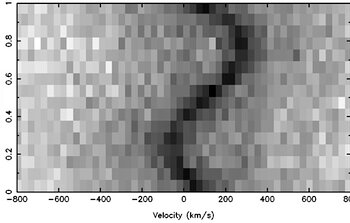Eclipsing Stellar Embers Offer Glimpse of Binary Demise
June 14, 2011

The chance alignment of a pair of helium white dwarfs – both originally about the mass of the Sun – is showing how binary stars interact and eventually suffer a long slow demise. The pair, known as CSS 41177, are held in a close gravitational embrace and aligned such that they eclipse each other as seen from the Earth. This serendipitous circumstance allows astronomers to explore the history of these stars, and their conclusions offer a laboratory to test models of stellar evolution and the extreme states of matter that white dwarfs exhibit.
The members of the binary pair, only the second of its kind known, have both endured extreme mass loss as a result of their close pairing. A white dwarf is the usual endpoint of stars like the Sun, but to end as a helium white dwarf, it must lose most of its outer hydrogen mass to reveal only the helium core. This can occur when two stars are tightly paired, as they are in the CSS 41177 system. Each of these stars lost material to its companion’s gravitational pull when it expanded during the red giant stage of its evolution.
The stars orbit each other every 2.8 hours, producing a deep primary eclipse that attenuates 40% of the total light and a secondary eclipse at the 10% level. The orbit is also evident in the Doppler shifts that show the stars’ motion towards and away from the observers through the cycle (Figure 1). The combination of the eclipses and spectral observations yields the precise measurements of mass and radius: each of these helium white dwarfs now has a mass of about 0.3 times the mass of the Sun and a radius of only 0.02 times that of the Sun. White dwarfs are much denser than normal stars, and understanding their mass-radius relationship remains a subject of ongoing investigation into the nature of their unusual state of matter.
The extreme circumstance of the orbiting white dwarfs releases gravitational waves that future generations of detectors may be able to measure. With this loss of energy from the system, the stars are gradually moving towards each other and will merge in just over 1 billion years.
Steven Parsons (University of Warwick, UK) led this work, using observations with the Gemini Multi-object Spectrograph (GMOS) on the Gemini North telescope in Hawai‘i and the RISE camera on the Liverpool Telescope in the Canary Islands.
Links
- The complete results will appear in The Astrophysical Journal Letters. A preprint is available.
